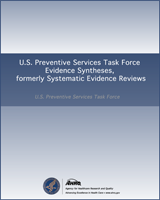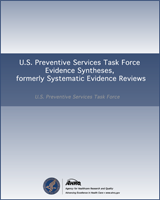NCBI Bookshelf. A service of the National Library of Medicine, National Institutes of Health.
This publication is provided for historical reference only and the information may be out of date.
Structured Abstract
Purpose:
This article focuses on whether it is useful to order a thyroid function test in patients who have no history of thyroid disease and have few or no signs or symptoms of thyroid dysfunction.
Data Sources:
A MEDLINE® search, supplemented by searches of EMBASE® and the Cochrane Library, reference lists, and a local database of thyroid-related articles.
Study Selection:
We selected controlled studies of treatment that used thyroid-stimulating hormone (TSH) levels as an inclusion criterion and reported quality of life, symptoms, or lipid level outcomes. We also reviewed observational studies of the prevalence, progression, and consequences of subclinical thyroid dysfunction.
Data Extraction and Synthesis:
Using preset criteria, we assessed the quality of each trial and abstracted information about its setting, patients, interventions, and outcomes.
Results:
The prevalence of unsuspected thyroid disease is lowest in men and highest in older women. Evidence regarding the efficacy of treatment in patients found by screening to have subclinical thyroid dysfunction is inconclusive. Several small, randomized trials of treatment for subclinical hypothyroidism have been done, but the results are inconclusive except in patients who have a history of treatment for Graves' disease, a subgroup that is not a target of screening in the general population. No trials of treatment for subclinical hyperthyroidism have been done. Data on the adverse effects of broader use of levothyroxine is sparse.
Conclusion:
Large randomized trials of treatment are needed to determine the likelihood that treatment will improve quality of life in otherwise healthy patients who have abnormal TSH levels and normal thyroxine (T4) levels.
Contents
- Preface
- Acknowledgments
- 1. Introduction
- Burden of Illness
- Definition of Screening and Case-finding
- Classification of Thyroid Dysfunction
- Accuracy of Screening Tests
- Prevalence
- Incidence
- Evidence Regarding the Complications of Subclinical Hyperthyroidism
- Evidence Regarding the Complications of Subclinical Hypothyroidism
- Prior Recommendations
- Analytic Framework and Key Questions
- 2. Methods
- 3. Results
- 4. Summary
- References
Prepared for: Agency for Healthcare Research and Quality, U.S. Department of Health and Human Services.1 Contract No. 290-97-0018, Task No. 2, Technical Support of the U.S. Preventive Services Task Force. Prepared by: Oregon Health & Science University Evidence-based Practice Center, Portland, OR.
This report may be used, in whole or in part, as the basis for development of clinical practice guidelines and other quality enhancement tools, or a basis for reimbursement and coverage policies. AHRQ or U.S. Department of Health and Human Services endorsement of such derivative products may not be stated or implied.
AHRQ is the lead Federal agency charged with supporting research designed to improve the quality of health care, reduce its cost, address patient safety and medical errors, and broaden access to essential services. AHRQ sponsors and conducts research that provides evidence-based information on health care outcomes; quality; and cost, use, and access. The information helps health care decisionmakers—patients and clinicians, health system leaders, and policymakers—make more informed decisions and improve the quality of health care services.
- 1
540 Gaither Road, Rockville, MD 20850. www
.ahrq.gov
- Review Screening for subclinical thyroid dysfunction in nonpregnant adults: a summary of the evidence for the U.S. Preventive Services Task Force.[Ann Intern Med. 2004]Review Screening for subclinical thyroid dysfunction in nonpregnant adults: a summary of the evidence for the U.S. Preventive Services Task Force.Helfand M, U.S. Preventive Services Task Force. Ann Intern Med. 2004 Jan 20; 140(2):128-41.
- Review Screening for and Treatment of Thyroid Dysfunction: An Evidence Review for the U.S. Preventive Services Task Force[ 2014]Review Screening for and Treatment of Thyroid Dysfunction: An Evidence Review for the U.S. Preventive Services Task ForceRugge JB, Bougatsos C, Chou R. 2014 Oct
- Clinical guideline, part 2. Screening for thyroid disease: an update. American College of Physicians.[Ann Intern Med. 1998]Clinical guideline, part 2. Screening for thyroid disease: an update. American College of Physicians.Helfand M, Redfern CC. Ann Intern Med. 1998 Jul 15; 129(2):144-58.
- Review Subclinical thyroid disease: scientific review and guidelines for diagnosis and management.[JAMA. 2004]Review Subclinical thyroid disease: scientific review and guidelines for diagnosis and management.Surks MI, Ortiz E, Daniels GH, Sawin CT, Col NF, Cobin RH, Franklyn JA, Hershman JM, Burman KD, Denke MA, et al. JAMA. 2004 Jan 14; 291(2):228-38.
- Review Screening for Hepatitis C Virus Infection[ 2004]Review Screening for Hepatitis C Virus InfectionChou R, Clark E, Helfand M. 2004 Mar
- Screening for Thyroid DiseaseScreening for Thyroid Disease
Your browsing activity is empty.
Activity recording is turned off.
See more...

